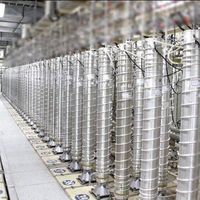US Signs Deals To Free Iraq From Iranian Energy
US and Iraqi companies have signed two deals, seemingly aiming to make the country independent from Iranian gas and electricity imports that provide billions of dollars to Tehran.
The deals are meant to capture Iraqi associated gas from oilfields, currently being flared due to lack of gas collecting equipment.
The US State Department released a joint statement after sealing the deal with Iraq, saying that the US has the potential to harness immense natural gas resources, invest in new energy infrastructure and renewables, and achieve energy self-sufficiency by 2030.
“The United States commended Iraq for its progress on gas capture and work on commercializing associated gasses,” the statement read.
Currently Iraq flares about 18 billion cubic meters (bcm/yr) of associated gas, ranking the second globally after Russia.
This amount of gas waste is two times more than Iraq’s annual gas imports from Iran.
Since the United States imposed banking sanctions on Iran in 2018, Iraq was not able to make cash payments to Iran, leading to the accumulation of around $11 billion in unpaid bills. The Biden administration, however, offered waivers to Iraq starting in June 2023 and the debt was paid in Oman, from where Iran is supposed to spend the money for buying "unsanctionable" goods.
However, critics have slammed the Biden administration for this decision, arguing that money is fungible and any hard currency Iran is able to access means that it can spend other currency resources on its military and other destabilizing activities.
Iraq's electrical grid has for years been dependent on gas imports from Iran to run its power generation plants. Iraq loses 4,000 to 5,000 MW of its electricity generation in some months, especially in winter and summer, due to halting Iranian gas and electricity deliveries to this country. Iran’s gas shortage soars to 250-300 mcm/d in winters and faces a 14,000 MW electricity shortage in summers, forcing it to reduce supplies to Iraq.
The country needs 40,000 MW of electricity, but its current generation capacity stands at 27,000 MW, of which 30% uses Iranian gas.
Iraq has projected to stop gas flaring by 2028 and reach energy self-sufficiency by 2030. It is working to reduce its heavy reliance on Iranian energy supply, which is subject to sanctions, requiring the US to issue waivers every four months.
Though Iraq recently extended a gas import deal with Iran for next five years, it has been trying to diversify energy import sources, including Turkmen gas import through Iran.
The joint statement says that US commended Iraq for its considerable work on increasing regional connectivity, particularly in energy interconnections with Jordan, Saudi Arabia, and countries of the Gulf Cooperation Council: “After years of work to build its interconnection with Jordan, Iraq is receiving 40 megawatts of electricity for the Iraqi people; future phases would increase capacity to 900 megawatts”.
Iraq’s gas and power deals
The agreements, signed in Washington in the presence of Iraqi Prime Minister Mohammed Shia al-Sudani and US officials, aims to capture above 3 bcm/yr of associated gas at the Bin Umar oilfield.
The memorandums of understanding signed between US companies including KBR, Baker Hughes and GE.N. as well as local Halfaya Gas Company, with Iraq's South Gas Company to capture flaring gas at Umar oilfield and construct a 400 km pipeline to transit the gas to processing facilities.
Iraq's oil ministry announced last month that it would work with Siemens Energy and SLB, formerly known as Schlumberger, to process associated gas.
Geoffrey Pyatt, assistant secretary for energy resources at the US State Department said the projects would be developed over the next couple of years.
Iraq had several deals with Western companies to capture associated gas, signed in the late 2010s. It could increase gas production by 30% between 2012-2017, but the growth stalled then due to plunging oil prices and government’s revenues.








